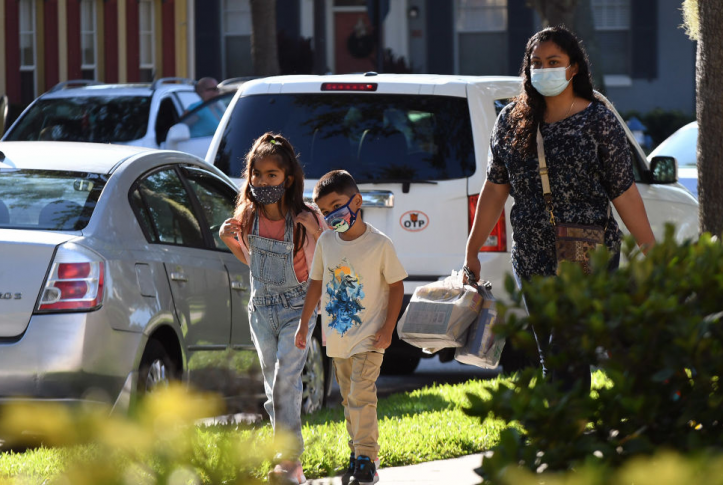On August 13, the Biden administration published guidance to help states prepare to wind down their special Medicaid program operations after the end of the federal COVID-19 public health emergency. First declared in January 2020, the emergency was most recently renewed in July. Given COVID’s persistence, the government has set no end date, and there is no way of knowing when the emergency will end. However, in a program as vital and complex as Medicaid, advance planning is essential.
The August guidance makes important modifications to earlier guidance issued by the Trump administration in December 2020. Nothing can truly soften the blow of widespread insurance losses that will occur when the special pandemic rules cease, and the harshest effects will be felt by minority Americans, who disproportionately depend on Medicaid because of higher poverty levels. But the update attempts to lessen the blow by giving states more time to wind down, which can reduce the potential for erroneous coverage terminations.
Medicaid’s Generous COVID-19 Policies
The pandemic caused Medicaid enrollment growth; indeed, as a means-tested program, Medicaid is designed to respond to adverse economic conditions. Additionally, the federal government and states pursued policies aimed at liberalizing eligibility for coverage for the people who have borne the pandemic’s worst effects.
First, the Families First Coronavirus Response Act (FFCRA) guaranteed that states that accept a 6.2 percentage-point increase in federal Medicaid payments (which all states did) can provide virtually all beneficiaries with continuous, uninterrupted enrollment for the duration of the public health emergency. Under normal circumstances, Medicaid enrollment is prone to interruption because even slight household income changes can lead to ineligibility.
Second, under special federal public health emergency powers, many states actually broadened eligibility, especially for people with serious disabilities who need long-term care. Together, these changes caused Medicaid and the Children’s Health Insurance Program (CHIP) enrollment to surge past 82 million by April 2021.
The wind-down will affect all Medicaid beneficiaries, not just recent COVID-related enrollees, since the protection applies to the entire population, not only to those who became eligible after the law’s March 2020 effective date.
Medicaid’s Special Enrollment Safeguards and the COVID Emergency
Medicaid is governed by long-standing U.S. Supreme Court precedent that bars states from reducing or ending assistance without a factual review of each individual case, advance notice that explains why benefits are ending, and an opportunity to appeal the decision. Federal Medicaid rules reflect these constitutional safeguards. These protections remain fully in effect during the pandemic, meaning that once the normal redetermination process resumes, safeguards against incorrect disenrollment without the opportunity to contest a state agency’s decision also must be in place.
December 2020 Trump Administration Guidance
The December 2020 guidance created several fundamental problems. First, the Trump administration gave states only six months to restore normal operations or face serious financial sanctions, meaning that in record time states were expected to clear a backlog of millions of redeterminations that would come due or face financial penalties. Second, to make this process even remotely feasible, the 2020 guidelines allowed states to begin redetermining eligibility prior to the end of the emergency period, using information up to six months old. This meant that when the pandemic ended, states could immediately terminate massive numbers of people based on dated information.
August 2021 Biden Administration Modifications
The August guidance modified the 2020 policy by lengthening the wind-down period to 12 months. Given this longer time period, the Centers for Medicare and Medicaid Services anticipates that states will have time to evaluate beneficiaries’ eligibility on the basis of more current evidence. Additionally, the new guidance expects that states will help people losing coverage enroll in other insurance for which they may be eligible, such as CHIP or subsidized marketplace plans. Enrollment in marketplace plans could be aided by a separate proposed rule to establish a year-round open-enrollment period for the lowest-income applicants. People transitioning from Medicaid to the marketplace would not need to wait for annual open-enrollment periods nor would they have to navigate the complex rules that apply to them.
Looking Forward
The August guidance will help. But there will still be pain — for beneficiaries in the middle of treatment who either don’t understand the notice or don’t know what to do; for states that face the task of ending coverage for many and the loss of FFCRA’s enhanced funding; for health care providers and Medicaid health plans with patients and members who will lose insurance; and for enrollment navigators who find themselves deluged with requests for help.
The most affected group may be very-low-income residents of states that have not expanded eligibility for Medicaid; these residents have been able to keep Medicaid coverage because of the continuous enrollment guarantee but they are unlikely to maintain coverage once it ends because of some states’ extremely restrictive eligibility rules. For example, Texas bars parents whose incomes exceed 17 percent of the federal poverty level from Medicaid unless they are pregnant or have a significant enough disability to be unable to work. Only Congress can fix that coverage gap. Legislation to do so to do so is now under consideration in the House of Representatives, and final action is expected later in the fall.

